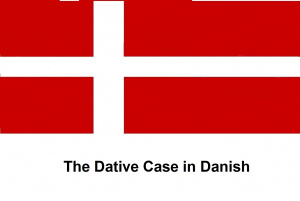Difference between revisions of "Language/Danish/Grammar/The-Dative-Case-in-Danish"
Jump to navigation
Jump to search
m (Quick edit) |
m (Quick edit) |
||
| Line 1: | Line 1: | ||
[[File:The Dative Case in Danish.jpg|alt=The Dative Case in Danish|thumb|The Dative Case in Danish]] | [[File:The Dative Case in Danish.jpg|alt=The Dative Case in Danish|thumb|The Dative Case in Danish]] | ||
Hello everybody, | Hello everybody, | ||
| Line 10: | Line 8: | ||
Feel free to edit this page by adding new words and expressions! | Feel free to edit this page by adding new words and expressions! | ||
Happy learning! :) | |||
. | |||
<span link>After mastering this lesson, these related pages might interest you:</span> [[Language/Danish/Grammar/Danish-Alphabet|Danish Grammar → Introduction to Danish Alphabet and ...]], [[Language/Danish/Grammar/Conditional-Mood|Conditional Mood]], [[Language/Danish/Grammar/Verbs-in-Danish|Verbs in Danish]] & [[Language/Danish/Grammar/Pronunciation-Basics|Pronunciation Basics]]. | |||
{| class="wikitable" | {| class="wikitable" | ||
|'''<big>THE DATIVE CASE</big>''' | |'''<big>THE DATIVE CASE</big>''' | ||
| Line 91: | Line 90: | ||
|} | |} | ||
== | ==Other Lessons== | ||
* [[Language/Danish/Grammar/Present-Tense|Present Tense]] | * [[Language/Danish/Grammar/Present-Tense|Present Tense]] | ||
* [[Language/Danish/Grammar/Future-Tense|Future Tense]] | * [[Language/Danish/Grammar/Future-Tense|Future Tense]] | ||
| Line 102: | Line 101: | ||
* [[Language/Danish/Grammar/Negation|Negation]] | * [[Language/Danish/Grammar/Negation|Negation]] | ||
* [[Language/Danish/Grammar/How-to-use-“to-be”-with-names-and-places|How to use “to be” with names and places]] | * [[Language/Danish/Grammar/How-to-use-“to-be”-with-names-and-places|How to use “to be” with names and places]] | ||
<span links></span> | |||
Latest revision as of 23:21, 26 March 2023
Hello everybody,
In today's lesson you will learn THE DATIVE CASE in Danish.
Feel free to edit this page by adding new words and expressions!
Happy learning! :)
After mastering this lesson, these related pages might interest you: Danish Grammar → Introduction to Danish Alphabet and ..., Conditional Mood, Verbs in Danish & Pronunciation Basics.
| THE DATIVE CASE | O CASO DATIVO | |
| ENGLISH | DANISH | BRAZILIAN PORTUGUESE |
| For (something) or (somebody) | Para (alguma coisa) ou (alguêm) | |
| To (some place) | Para (algum lugar) | |
| FOR ONE HOUSE | TIL ET HUS | PARA UMA CASA |
| FOR THE HOUSE | TIL HUSET | PARA A CASA |
| FOR SOME HOUSES | TIL NOGLE HUSE | PARA ALGUMAS CASAS |
| FOR THE HOUSES | TIL HUSENE | PARA AS CASAS |
| FOR ONE MAN | TIL EN MAND | PARA UM HOMEM |
| FOR THE MAN | TIL MANDEN | PARA O HOMEM |
| FOR SOME MEN | TIL NOGLE MÆND | PARA ALGUNS HOMENS |
| FOR THE MEN | TIL MÆNDENE | PARA OS HOMENS |
| I GAVE MY WATER TO THE DOG | JEG GAV MIT VAND TIL HUNDEN | EU DAVA MINHA ÁGUA PARA O CÃO |
| I WILL GO TO THE BEACH | JEG VIL GÅ TIL STRANDEN | EU IREI À PRAIA |
Other Lessons[edit | edit source]
- Present Tense
- Future Tense
- How to use “be” with adjectives in Danish
- Possessive Case in Danish
- How to use “can” in Danish
- Conditional Mood
- The Ablative Case in Danish
- The Nominative Case in Danish
- Negation
- How to use “to be” with names and places
